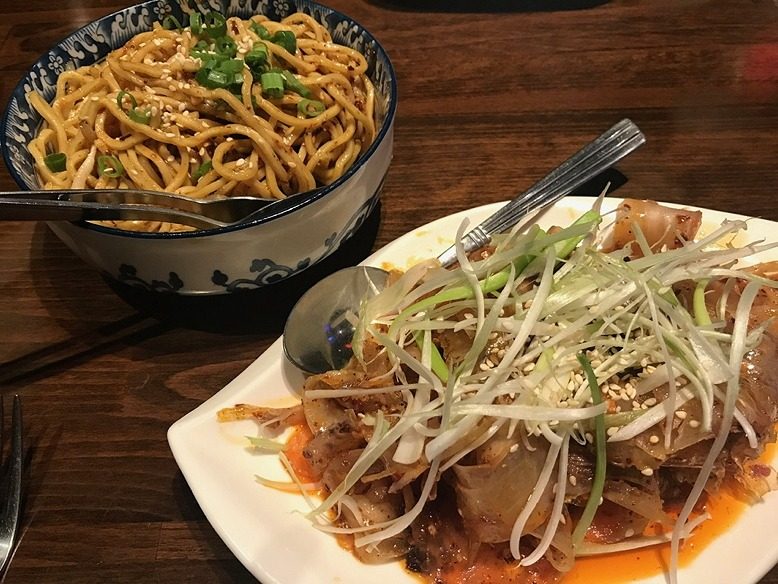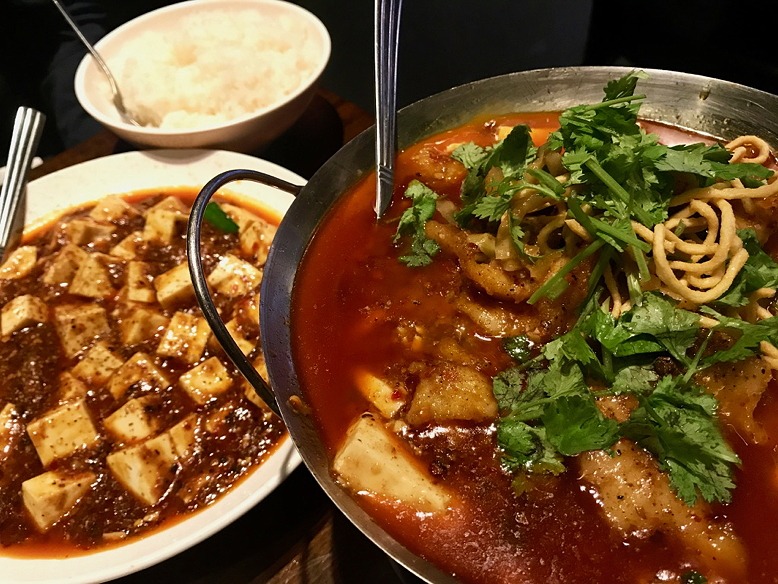
While the skill of a Szechuan chef may be assessed through their ability to balance four primary flavor components—ma (numbing), la (hot), xian (fresh) and xiang (fragrant)–it is in their chili oil that one detects their passion. Chili oil is personal. It leaves its mark both figuratively and in an ombre ring of red on the plate. Chili oil is alchemical. It expresses more than the sum of the peppers, spices and oil of which it’s made.
At Taste of Szechuan in Cherry Hill (one of our hottest new restaurants of 2019), the chili oil is so resonant and flavorful that customers ask owners PinJun and Dandan Yue when they will bottle it.
“The chili oil, that’s special,” says Dandan, who runs the front of the house like clockwork while her husband turns out a roster of Szechuan (also spelled Sichuan) dishes. “Every Szechuan restaurant has their own chili oil, and every Szechuan chili oil is different. We don’t sell it, but lots of the customers suggest that we could. My husband says no. That’s our secret!”

Taste of Szechuan menu. Photo by Jenn Hall
That well-guarded recipe is all the more reason to plan a stop anytime you are in the area, or even if you are not. Drawing on their home city of Chengdu as muse, the couple has crafted a deep menu of traditional dishes that together express the poetry and complexity of one of China’s eight great cuisines.
A meal here can serve as a meditation on the color red: that fire-hued oil adding la (heat) to dishes from hot pot to ma po tofu—though don’t forget the ma. “When you taste Szechuan cuisine, it’s not only hot from different chili peppers. It also gives you the tinging feeling on your tongue. The numbing flavor, ma, comes from the beautiful Szechuan peppercorns.”
Szechuan cuisine leverages balance to create powerful flavors, and PinJun is a class-two master chef in the cuisine. In his hands, a culinary tradition that honors harmony is expressed as much through those four central flavor elements as through texture.
To experience the latter, begin with beef tendon in chili sauce. Adorned with scallions, it arrives piled in ribbons that are stained scarlet by a deft combination of sesame, chili, and Szechuan peppercorn oils. The dish is deeply savory with a singular, peppery snap achieved through a multi-step process of boiling, cooking on fire, cooling and slicing. Serving as a textural foil to the tendon, Chengdu cold noodles in (yes) chili oil are bright-sweet, carrying a whisper of dark vinegar and peanut crunch. They veer rust-red against the brighter orange of the tendon, luscious oil pooling beneath tangle of chewy wheat noodles.

Ma po tofu, left, and fish fillet with tender tofu. Photo by Jenn Hall
Both dishes showcase a Szechuan custom of serving cold, savory starters before a meal. “A Sichuanese feast always begins with a teasing spread of cold dishes to arouse the senses, ‘open the stomach’ (kaiwei) and set the mood for the meal to come,” writes Fuchsia Dunlop in her just-released The Food of Sichuan, which updates her classic Land of Plenty from 2001. At Taste of Szechuan, such traditions are central to the experience. “We come from Chengdu,” Dandan says with her trademark smile. “The beef tendon and the Chengdu cold chili noodles, if you had them there, they would be almost exactly the same.” The restaurant pays homage to their home city, highlighting the specific, complex flavors of a food-obsessed province that names no fewer than 23 core flavor profiles.
As recently as 15 years ago, Dandan says, most Chinese restaurants stateside were in the American style. (Think sweet and sour.) “Now, a lot of American people can travel to China, or they have Chinese friends or Chinese family members, so they know what the real Chinese flavor is. We keep it 95 percent Chinese traditional.” Here, the emphasis is on Chinese flavor, with a few Americanized classics thrown in, like a simple, sublime wonton soup laced with white pepper and handmade dumplings that is altogether soothing on a dreary day.
Savoring a gorgeously old-school ma po tofu, yielding soy is balanced with rich bass notes courtesy of minced pork. Sizzling in a hot pot lit by gas flame, fish filet with tender tofu brings together fresh flounder and soy protein in a sea of sizzling red, brightened by Szechuan pickle (and yes, chili oil). A word to the hungry: you will leave with leftovers, all the better by which to relive a special dining experience.
“My dream is that I want to share not only the dishes from Szechuan, China but also the Szechuan culture,” Dandan says. Someday, that might include a few more restaurants, and perhaps a hand or two to help make the 1,500-plus dumplings the restaurant serves each week. (Dandan helps out with those. “They kind of make me crazy,” she laughs, though she can bang them out in three hours.) Until then, it is well worth the drive to Cherry Hill to experience PinJun’s trademark chili oil and Dandan’s warm welcome in person.
Taste of Szechuan, 2091 Marlton Pike East, Cherry Hill; 856-888-1370. Open 11:30am–9:30pm, Monday – Saturday; and 11:30am– 9pm on Sunday.
